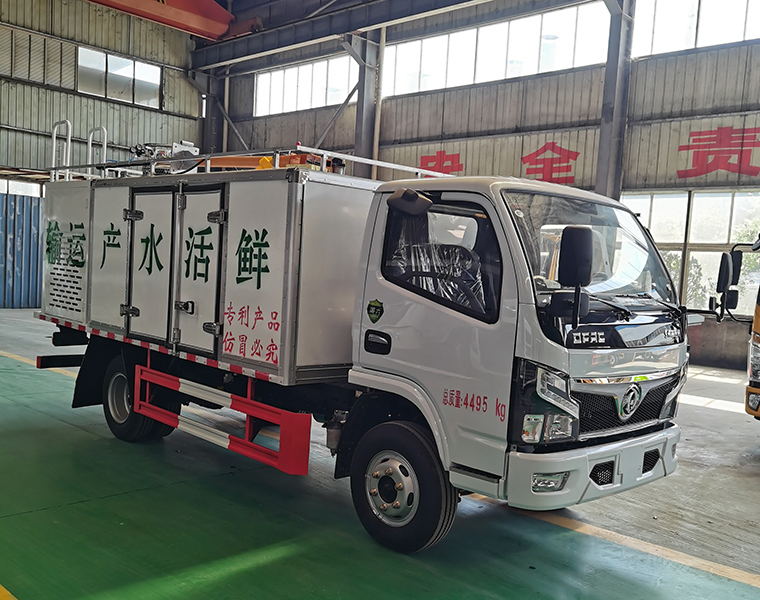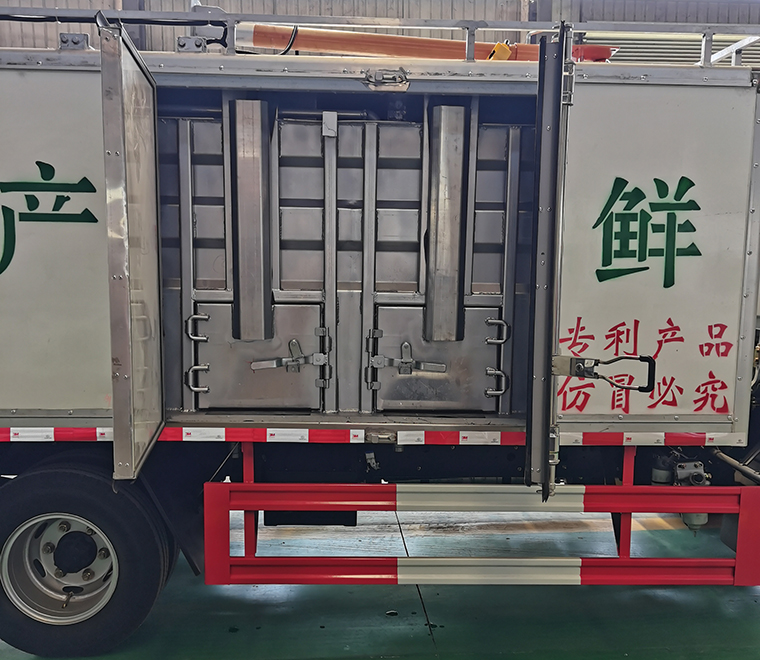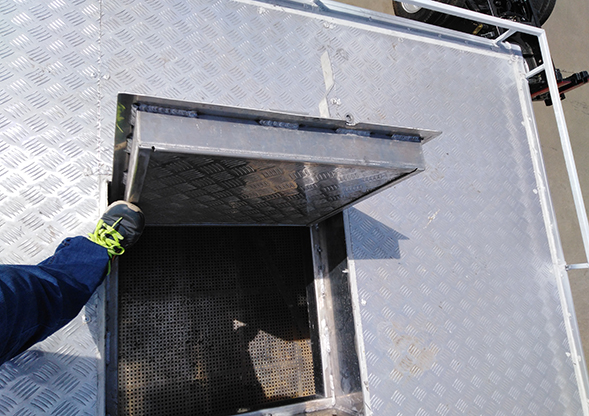Reefer truck and insulated truck series: Fresh fish transport truck product introductio
Fish fry transport vehicle:Dimensions: 5998X2300X2900, tank volume 5 cubic meters, can carry 3.4 tons of live fish, seafood, fry, a small fish vehicle developed for short-distance transportation, with main functions including life support system, oxygenation system, water circulation filtration system, constant temperature system, water temperature monitoring system, underwater lighting system, electronic control system and water circulation pump, etc. It adopts water circulation refrigeration unit, independent oxygen supply, water circulation filtration, polyurethane foam insulation, independent compartments, and crane to unload fish. Independent oxygen supply system: adjust the oxygen level in the cab through the pressure reducing valve, and send oxygen to each fish tank. One tank can be used for 30 hours. Water circulation refrigeration technology: the refrigerator is driven by an independent diesel generator, and the water temperature is lowered by the water refrigeration principle. The water temperature is controlled at 10-18 degrees in summer, and the refrigeration unit can continue to work when the car is parked. Aluminum alloy tank body: light material with good thermal conductivity, can quickly lower the water temperature, polyurethane foam insulation: keep the water temperature from rising, and keep the air inside the fish tank and outside, and always keep the water temperature from rising. Circulation filtration: purify the water quality. The water quality of each tank is cleaned by a circulation filter pump, and the fish feces and impurities in the water are filtered out by the filter pump. It is more labor-saving to load and unload fish with a crane. The fish outlet ring cloth material can prevent fish scales from being scratched by unloading fish. According to the size of the vehicle model, 2-3 independent sub-compartments can be made, and they can be packed in different warehouses according to the different types of fish. There are advantages such as no water change, no ice addition, and no dead fish during long-distance transportation in summer.


It is mainly used for long-distance transportation of live fish and seafood in summer without changing water or adding ice. The upper configuration: total mass 18 tons, can pull 5 tons of live fish without overloading, independent pump room oxygen generator, fish can be transported when the outdoor temperature is above 30 degrees in summer (the fish-to-water ratio is 1:1). In winter, when the temperature is low, more fish can be transported. The ratio of fish to water is (6:4). In summer, the water temperature can be controlled at around 15-18 degrees through the refrigeration unit. There is no need to change water or add ice within 50 kilometers. Our fish trucks have run about 4,000 kilometers and have a high survival rate.

Independent oxygen supply
A vehicle is equipped with two liquid oxygen tanks as standard (3 or 4 can be added depending on the distance). Liquid oxygen is connected to the bottom of each fish tank through nanotubes, so that each fish can absorb sufficient oxygen. The oxygen volume is adjusted through the pressure reducing valve, which can be adjusted in the cab. A liquid oxygen tank holds 210 liters and can be used for more than 30 hours.
Constant temperature refrigeration
Each vehicle is equipped with a 10-kilowatt generator, which drives the compressor to work. The water refrigeration technology achieves rapid cooling. The water temperature is controlled at 10 to 18 degrees in summer. The generator can run automatically when the vehicle is parked. The temperature can be lowered in one hour through the principle of water circulation refrigeration. The external insulation layer of the fish box plays a role in constant temperature. Fish are less active under low temperature conditions, so fish can avoid swimming around and losing weight. Lowering the water temperature can reduce the activity of live fish during transportation, weaken metabolism, and reduce the emission of ammonia nitrogen and CO2, which guarantees water quality to a certain extent; at the same time, it can reduce the damage caused by collision and biting between aquatic products and ensure the quality of live aquatic products. Since most aquatic products are sensitive to temperature, sudden changes in the environment can cause them to become sick or even die. Therefore, during transportation, gradient cooling should be selected, and the cooling rate should not exceed 3℃/h. After the transportation reaches the destination, the water in the destination water tank and the transport water should be gradually mixed. After the transported aquatic products adapt to the temperature and other environments, they can be moved into the new water tank.
Circulation filtration
Honda's integrated generator drives the circulation filter pump to circulate and filter the water in the fish tank to optimize the water quality. There is a sewage discharge device at the bottom of the filter pump. The valve can be opened to quickly discharge sewage, fully reducing the metabolism of live aquatic animals during transportation. According to user needs, a double circulation filtration system can also be used.
Polyurethane insulation
According to the principle of refrigerator insulation, there is a 10mm insulation layer on the outside of the tank. The insulation material is polyurethane foam, which has low cost and good insulation performance. It can effectively keep the temperature in the box from rising. The outside of the insulation box is made of stainless steel, which is non-slip, rust-proof and durable. Hard polyurethane is fireproof, flame retardant and high temperature resistant. It can effectively prevent the spread of flames. Moreover, polyurethane does not produce harmful gases at high temperatures.
Fish-filling port sinking technology
Fish-filling port sinking technology: As the saying goes, full water does not shake, half-filled water shakes. Fish-filling port sinking means filling the fish box with water. If the water is not fully filled during transportation, it will shake back and forth. The fish will be frightened and will bump around and get injured. Fish-filling port sinking will reduce the harm of live fish being injured.
Water outlet at the bottom of the tank
The water outlet at the bottom of the tank can better drain the water in the fish box, which is convenient for cleaning the inside of the tank. In winter, clothes will not be wetted by the impact of water discharge, and it can also optimize the water quality.
Independent warehouse
According to the user's demand for long-distance transportation of live fish, we can divide the warehouses for different species of fish independently. Each warehouse can hold different species of fish. Each warehouse is about two cubic meters. Each warehouse has a fish-filling port, a fish-unloading port and two water outlets. 1,000 kilograms of fish can be held per cubic meter of water, and the fish-water ratio is 1:1.
Crane unloading fish
A 300 kg 24V electric crane is installed on the top of the box, which can rotate 360°, greatly saving manpower and material resources. When the crane is not in use, remove the screws and lie flat on the top of the fish box.
Monitoring water temperature
The temperature sensor is installed inside the fish box and connected to the cab, which can quickly grasp the temperature changes in the fish box. In the face of special situations, it can be predicted in advance and quickly controlled.
Night lighting
There is a power socket behind the cab, and a lighting socket at the tail of the box, which is mainly convenient for night operations. There are railings around the top of the fish box to prevent accidents.













